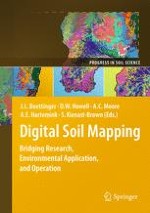2010 | OriginalPaper | Buchkapitel
Random Forests Applied as a Soil Spatial Predictive Model in Arid Utah
verfasst von : A.K. Stum, J.L. Boettinger, M.A. White, R.D. Ramsey
Erschienen in: Digital Soil Mapping
Verlag: Springer Netherlands
Aktivieren Sie unsere intelligente Suche, um passende Fachinhalte oder Patente zu finden.
Wählen Sie Textabschnitte aus um mit Künstlicher Intelligenz passenden Patente zu finden. powered by
Markieren Sie Textabschnitte, um KI-gestützt weitere passende Inhalte zu finden. powered by
We sought to predict soil classes by applying random forests (RF), a decision tree analysis, to predict 24 soil classes across an arid watershed of western Utah. Environmental covariates were derived from Landsat 7 Enhanced Thematic Mapper Plus (ETM+) and digital elevation models (DEM). Random forests are similar to classification and regression trees (CART). However, RF is doubly random. Many (e.g., 500) weak trees are grown (trained) independently because each tree is trained with a new randomly selected bootstrap sample, and a random subset of variables is used to split each node. To train and validate the RF trees, 561 soil descriptions were made in the field. An additional 111 points were added by case-based reasoning using photo interpretation. As RF makes classification decisions from the mode of many independently grown trees, model uncertainty can be derived. Furthermore, the probability that a pixel belongs to one or more classes in the legend can be determined. The overall out of the bag (OOB) error for discrete classes was 55.2%. The confusion matrix revealed that four soils that frequently co-occurred on landforms were frequently misclassified as each other. These soils were combined into six soil map units. To identify pixels that might belong to one of these newly created combinations of soil classes, minimum threshold probabilities were set. Employing probability by class can be an effective and objective method of determining membership in soil map unit associations and complexes mapped at the 1:24,000 scale.
